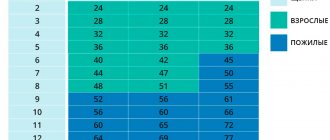Although dogs live shorter lives than their owners, just like people, they go through various stages of life, including childhood, adolescence, maturity and old age. And understanding what age a pet is by human standards will help you understand it, determine its needs and find an approach to raising it. But, since there are different approaches to how to recalculate dog years to human age, it is necessary to determine the option that is closest to reality.
How to calculate a dog's age - a modern approach
Converting dog years to human ages is a complex task that requires taking into account many factors. It is impossible to fully cover all aspects of development, physiological characteristics in accordance with the breed and living conditions of pets. Therefore, for calculations, data obtained from companies insuring pets and from veterinary clinics is used, plus statistics from examinations carried out in kennel clubs are collected. Based on this, in 2022, a group of scientists from America decided to conduct their own research, according to which they were able to create a formula that allows them to calculate dog years:
Pet's age in human years = 16 × ln(dog's age) + 31,
where ln is the natural logarithm
Logarithmic function for epigenetic translation from dog age (x-axis) to human age (y-axis). Illustration from the study Quantitative translation of dog-to-human aging by conserved remodeling of epigenetic networks
A more simplified approach is offered by the American Veterinary Medical Association: their general guidelines state that the age of pets by human standards can be calculated as follows:
- The 1st year of a dog’s life is equal to 15 human years.
- In the 2nd year, the pet lives 9 human years.
- Each subsequent year is equivalent to 5 human years.
Counting errors
There are many errors in the calculations. Each dog has an individual development, which makes it almost impossible to accurately determine a “human” age. Some errors are more common.
- In a simplified calculation, the first year is counted as 7 years. The first 365 days in a dog's life are underestimated - during this time the animal's development occurs at double the pace. Muscles are being formed and preparations are underway for puberty. For this reason, counting the first year of a dog’s life as 7 is incorrect. To avoid error, you need to take the first 12 months as 14-15 human years.
- The second year of a dog's life is also considered an important period in a dog's life. While a simplified calculation considers the second year to be 7, it should be thought of as 9-10 years. This often causes confusion in calculations, but these conditions cannot be neglected.
- Kleiber's law does not specialize in dogs. For this reason, factors such as the breed and physiological characteristics of the pet are not taken into account in the equation. Therefore, Kleiber's law is not accurate when the breed of a quadruped implies a shorter life span than other breeds.
How was the age of dogs calculated in the past?
For a long time, people were interested in how to understand how old a dog is in comparison with them. Therefore, research was carried out and assumptions were made. Some theories were close to reality, others were as far away as possible. But each should be considered separately.
1 dog year = 7 human years
Initially, it was decided that the age of dogs was calculated simply - 1 human year is equal to 7 dog years. This judgment arose by dividing the average life expectancy of a person, taken as 70 years, by the average life expectancy of pets, taken as 10-12 years.
The formula was subject to serious criticism, since it assumed that by the end of the first year of life, a furry pet is developed at the level of a 7-year-old child, and by the end of the second, it reaches the level of a 14-year-old teenager. But since a one-year-old dog is considered an adult, since the dog is capable of reproducing, and the human body matures up to 14-15 years, the calculation lost its meaning and became erroneous.
The theory of the French veterinarian Lebeau
The Frenchman Lebeau, who worked as a veterinarian, in 1950, conducted a series of studies on the physiology of dogs and proposed a new approach to calculation. In its version, dog years are correlated not only with the overall length of life, but also with the physical and psycho-emotional development of the pet. Lebeau suggested that it would be possible to translate dog ages according to humans as follows:
- 1 year is equivalent to 15 years.
- 2 years corresponds to 24 years.
- 3 years are equivalent to 28 years and then 4 human years are added every year.
That is, as a result of his research, from the age of 2, four-legged family members lived 1 year as 4 years of a person. But since Lebeau did not take into account the individual characteristics of pets and the conditions in which they were kept in his studies, such a calculation was considered suitable only for pets of small breeds.
Swiss biologist Kleiber's law
Max Kleiber, Swiss biologist
Swiss scientist Max Kleiber, being a biochemist by profession, was able to create the most accurate theory. In his research, he was guided by a previously discovered law that spoke about metabolic processes in the animal body, and through a series of experiments he was able to find out that large animals live longer. But this system works in the opposite way in the case of dogs. Based on his work, we can say that the older dogs become, the greater the difference between their biological age and the corresponding human years.
This trend can be illustrated by the Pekingese and Labrador. A Pekingese turns 15 years old in one year, 23 years old in 2 years, and 36 years old in 5 years. And in the case of a Labrador, in one year it is comparable to a 14-year-old teenager, in 2 years the Labrador reaches 29 years old by human standards, and in 5 years it reaches 45 years.
But there are also exceptions. It is known that the body of small breed dogs contains substances that help slow down the aging process, which increases the years of life.
Cheat sheet for foundling owners
If a new family member is picked up on the street or taken from a shelter, then his age will be determined by the condition of his teeth, eyes and internal organs, as well as the appearance of his skin and fur. Often you cannot do without x-rays and ultrasound, so only a veterinarian will provide accurate data. If a trip to the veterinary clinic is not possible in the coming days, then pay attention to:
- Elasticity and color of wool. Loose skin and gray hair are characteristic of older animals.
- Eyes. The older the dog, the worse his vision and the cloudier his pupils.
- Cleanliness and wear of teeth. Up to 2 months, puppies have milk teeth with snow-white enamel. By 7 months they change to native ones, but do not lose their whiteness. Darkening of the enamel and yellowness indicate that the animal is older than 7 months, but younger than 2 years. From the age of 2 the first tartar appears, and after 5 years there is noticeable wear on the surface of the teeth. The absence of some teeth and an abundance of tartar is observed in dogs over 10 years old.
Please note that the presented pattern directly depends on lifestyle. If a dog has lived on the street for a long time, then the condition of his teeth will be worse than that of a four-legged pupil from a good shelter.
Dog age to human age
You can determine how old a dog is in human years by taking into account which weight group the pet belongs to:
- Small – 9 kg or less.
- Average – 10-21 kg.
- Large – 22-45 kg.
- Huge - 46 kg or more.
1 year
By human standards, the first dog year for a small, medium and large dog is equivalent to 15 years, and for a large dog - to 12.
2 years
At 2 years, the ratio of the age of a dog to a person for small, medium and large pets is equal to 24 years, for large ones - to 22.
3 years
Having reached 3 years old, a small, medium and large dog is developed at the level of a 28-year-old person, and a huge one - at the level of a 31-year-old person.
4 years
Having lived for 4 years, a small, medium in weight and large dog is considered 32 years old by human standards, a huge one is 38 years old.
5 years
At the onset of the 5th year of life, the dog years of a small, medium and large pet in human years are equal to 36, and for a large pet to 45.
6 years
Starting at 6 years of age, a difference in human years is present in all dogs:
- small – 40 years;
- average – 42 years;
- large – 45 years;
- huge - 49 years old.
By the age of 6, a small furry companion reaches 40 human years, a medium one - 42, a large one - 45, a huge one - 49.
7 years
At the age of 7, a four-legged family friend is considered to be developed by analogy with a person:
- small – 44,
- average – 47,
- large – 50,
- huge – 56.
8 years
By the age of 8, the psychological and physical age of the pet, by human standards, approaches:
- small breeds – 48;
- representatives of medium breeds – 51;
- large – 55;
- huge – 64.
9 years
At 9 years old, a small dog is considered to have reached 52 human years, a medium one - 56, a large one - 61, and a huge one - 71.
10 years
From the age of 10, dog years in small breeds approach 56 human years, medium - 60, large - 66, huge - 79.
11 years
Having lived like a dog for 11 years, the small four-legged friend turns about 60 years old, the medium one - 65, the big one - 72, the huge one - 86.
12 years
By the time a dog turns 12 years old, the psychological and physical condition of a dog of small breeds is translated into 64 human years, medium - 69, large - 77, huge - 93.
13 years
From 13 years of age, breeders can consider a small dog to have grown to 68 years of age. An average pet reaches 74 years, a large one - 82, a huge one - 100.
14 years
By the time a dog turns 14 years old, the dog years of a small dog, by analogy with people, are equal to 72 years, a medium one - 78, a large one - 88, a huge one - 100.
15 years
At the age of 15, a small pet is considered to have reached 76 human years, a medium one - 83, a large one - 93, and a huge one - 114.
16 years
Having reached 16 years of age, small dogs are compared to an 80-year-old person, medium - 87, large - 99, huge - 121.
17 years
At 17 years old, the dog age of representatives of small breeds is considered to be equal to 84 human years, medium - 92, large - 104, huge - 128.
18 years
By the onset of the 18th year of life, the human age for a small breed is equal to 88 years, for a medium breed - 96, for a large one - 110, for a huge one - 135.
Kleiber's Law
When determining the age of a pet, we must not forget about an important breed feature - the size and weight of the animal . In 1930, the Swiss biologist M. Kleiber formulated the “Metabolic Law of 3/4”. According to this law, the rate of metabolic processes in a living organism directly depends on the size of the animal (weight of the animal). Thus, the greater the mass of the animal, the longer it will live.
How are things really going? Yes, the law applies to warm-blooded animals from a tiny mouse to a giant elephant. However, this dependence is not observed among representatives of different breeds, only within the species.
For example, the life expectancy of a Great Dane, whose weight reaches 90 kg, rarely exceeds 7-8 years. But an Italian lapdog weighing 2.5-3 kg will please the owner for 15 years or more.
Life expectancy of representatives of popular breeds:
- Welsh Corgi - 13/68 years old,
- chihuahua – 14 / 72 years
- Pomeranian Spitz - 15/76 years old,
- miniature poodle – 15/76 years,
- boxer -10.5/60 years,
- King Charles Spaniel – 10/60 years,
- Airedale Terrier -10 / 60 years
- Dogue de Bordeaux - 7-8 / 56-64 years,
- Bernese Mountain Dog - 8/64 years old,
- Irish Wolfhound - 7 years / 56 years.
The reason for this discrepancy is not determined. Veterinarians believe that this is due to the level of a specific hormone that slows down the aging of the animal’s body.
What dog breeds live the longest?
The top 5 breeds with the longest life expectancy include:
- The New Guinea Singing Dog is a population discovered in the mid-20s. The breed is still being studied and parameters for classification are being determined, but the life expectancy turned out to be impressive - 18 years.
New Guinea singing dog
- The Chihuahua is a small breed native to Mexico. Being a companion dog and being one of the smallest breeds, these pets have an amazing lifespan of 17 years.
Chihuahua
- The toy poodle is a decorative German breed that resembles a charming plush toy and has a lot of positive qualities. This includes a life expectancy of up to 16 years.
Poodle
- The Jack Russell Terrier is a breed bred in Great Britain, intended for hunting. Now, regardless of whether the pet is involved in the original activity or plays the role of a furry companion, its life can last up to 16 years.
Jack Russell Terrier
- The cockapoo is a designer cross between a cocker spaniel and a poodle, also called a cockerpoo or spoodle. As a result of selection, these fluffy beauties have acquired good health and can live 16 years.
Cockapoo
Neutered and non-neutered dachshunds
If you have two dogs of different sexes at home at the same time and do not intend to breed the breed, it is recommended that the boy be neutered. This will allow him to remain calm during the girl's heat and will increase his life expectancy.
How long do dogs live at home: table by breed
It is advisable to sterilize the female. This procedure improves the pet's health. But at the same time, you should pay attention to weight gain, since after surgery the likelihood of obesity increases.
Note! If the procedure is performed too early, when the dog’s body has not yet matured, this can cause a number of problems with the genitourinary system.
The operation is usually performed at the beginning of puberty. For small breed males this is 7 months of age, for females - from six months to 9 months (before the start of the first heat). At this time, the dog’s sexual instinct is not yet fully formed; it does not mark its territory. But at the same time, development is in its final stage, and the procedure does not cause complications.
After spaying and neutering, the veterinarian will provide recommendations for caring for the dog. Following the advice of a specialist will help your pet avoid complications and recover faster.
Important! When prescribing medications for the rehabilitation period, you must remember to administer them on time. If alarming signs appear, you should immediately seek advice from clinic specialists.
You can go for a walk with the dog already on the third day after the procedure. In this case, it is definitely recommended to protect the seam from dirt and moisture. For a couple of weeks, it is worth limiting the dog’s activity outside to calm walking and not walking for too long.
What dog breeds live the shortest?
Pets with the shortest life expectancy include:
- The Dogue de Bordeaux is a strong and impressive pet, originally from France, with a calm and confident character. But, despite a lot of positive qualities, this breed lives for 5-8 years.
Dogue de Bordeaux
- The Great Dane is a giant beauty bred in Germany and is rightfully considered a true aristocrat. His appearance and character are suitable for raising a confident and devoted family pet, but he lives for 6-8 years.
German dog
- The Bernese Mountain Dog is a herding breed originally from Switzerland and has a number of universal qualities. But its life expectancy is within 6-8 years.
Bernese Mountain Dog
- The Irish Wolfhound is a calm and impressively sized dog from Ireland bred to hunt large game. Despite the fact that these dogs are now rarely involved in the original business, their health and growth rate lead to a life expectancy of 6-10 years.
Irish Wolfhound
- Neapolitan Mastiff - brutal beauties originally from Italy have a long history and many positive qualities. But they live 7-9 years.
Neapolitan Mastiff
Life expectancy for boys and girls at home
According to official data, the life expectancy of a Labrador is from 13 to 15 years.
But, this figure may fluctuate depending on many factors:
- Heredity.
- Conditions of content.
- Food quality.
- Number of births (for bitches), etc.
If a dog has good heredity and receives proper care, then the likelihood that it will live to a ripe old age is 90-95%. In this case, the maximum lifespan will be 15 years.
If conditions are not ideal, the lifespan will be 8-9 years. This figure is the minimum.
It is believed that females live longer than males by 1-2 years. But in practice this is not the case. The fact is that each birth of puppies wears out the bitch’s body, and therefore reduces life expectancy.
According to experienced breeders, Labrador retriever males and females live approximately the same number of years in good conditions.
Why do small dogs live longer than big ones?
The phenomenon that small breeds have a longer life expectancy than large dogs has long raised questions among scientists and dog handlers. Evolutionary biologist at the University of Göttingen in Germany, Cornelia Kraus, argues that big dogs are going through the aging process at an accelerated rate. Scientists believe that every 2 kg of body weight reduces the life expectancy of a four-legged pet by about a month. And, despite the fact that a clear reason for this has not been determined, Kraus has several assumptions. These include the fact that larger individuals succumb to age-related pathologies earlier, and that accelerated growth rates increase the likelihood of abnormal cell growth, which affects the quality of health.
The oldest living dog is the miniature dachshund Fanny, who lives in Japan. The baby was born on 05/27/1999 and at the time of checking the record by a representative of the Guinness Book of Records (11/12/2020) she was 21 years and 169 days old.
Miniature dachshund Fanny is the oldest living dog (21 years and 169 days).
Currently, canine gerontology is an actively developing field of science. Therefore, scientists continue to work, and plan to further find out what the relationship is between the size and lifespan of a dog. They also set themselves the goal of slowing down the aging of pets and promoting longevity while maintaining good health.
Fairness of the matching rate
The correspondence coefficient presented in the table is also conditional to a certain extent. When converting a dog's age to a human one, A le Beau found that in the first years of life animals develop faster than at a more mature age; accordingly, at this time they live longer in a human year than in old age. To prove this, he compared:
- the moment of puberty;
- the onset of maturity (when the dog turns from a teenage puppy into an adult);
- life expectancy.
In the process of studying animals, the scientist did not take into account their size and breed, which led to errors that the researchers tried to explain using Kleiber's law.
According to him, large breeds of dogs should live longer, since the metabolic rate is related to the weight of the living organism. However, in reality this is far from the case. Small dogs (terriers, lapdogs, Pekingese) live longer than their larger counterparts. Presumably this is due to delayed cell death in small animals. The aging process slows down and the risk of developing diseases decreases.
Long-lived dogs from the Guinness Book of Records
More than 20 long-lived dogs are registered in the Guinness Book of Records, whose age is documented.
The title of the Oldest Dog in the World still belongs to the Australian Cattle Dog (Australian Heeler) named Bluey. The dog lived for almost 29.5 years and this record has not yet been officially broken!
Bluey is the oldest dog ever living Photo: wikipedia.org
| Nickname | Years of life | Age | Breed |
| Bluey | 1910-1939 | 29 years 160 days | Australian Cattle Dog |
| Butch | 1975-2003 | ≥28 years 0 days | Beagle |
| Taffy | 1975-2003 | 27 years 211 days | Welsh Sheepdog |
| Snookie | 1991-2018 | ≥27 years 284 days | Pug |
| Bramble | 1975-2003 | 27 years 211 days | Border Collie |
| Adjutant | 1936-1963 | 27 years 98 days | Labrador Retriever |
| Buksi | 1990-2017 | 27 years | Cur |
| Pusuke | 1985-2011 | 26 years 248 days | Shiba Inu mix |
| Sugar | 1952-1977 | 24 years 360 days | Unknown |
| Piccolo | 1987-2010 | 23 years 86 days | Pug |
| Funny | 1999-present day | 21 years 169 days | Miniature Dachshund |
| Chanel | 1988-2009 | 21 years 114 days | Dachshund |
| Otto | 1989-2010 | 20 years 334 days | Mixed dachshund and terrier |
| Seamus | 1993-2014 | 20 years 298 days | toy poodle |
| Sotirakis | 1993-2014 | 20 years 280 days | Cur |
| Megabyte | 1993-2014 | 20 years 265 days | Chihuahua |
| Murzyn | 2000-present day | 21 years, 227 days | Cur |
| Winston Rha | 1992-2013 | 20 years 154 days | Schnoodle (a cross between a schnauzer and a poodle) |
| Lady | 1999-2019 | 20 years 130 days | Dachshund |
| Willie | 1994-2014 | 20 years 106 days | Jack Russell Terrier |
| Scolly | 1993-2013 | 20 years 33 days | Dachshund |
According to wikipedia.org
Scientists studied the phenomenon of the Australian heeler Bluey in 2011, but after testing 100 dogs, they came to the conclusion that Bluey’s longevity is rather an exception to the rule, because The average lifespan of the Australian Cattle Dogs studied was 13.5 years (±2 years).
Main causes of premature death
The most common causes of death among Labradors:
- Gastric volvulus. This is an acute dilatation of the stomach due to weakness of its wall. The disease is characterized by an increase in the size of the stomach (bloating), which entails compression of the diaphragm and impaired circulation in the internal organs, which leads to death.
- Tracheal collapse is a chronic disease with common causes. It is characterized by a narrowing of the lumen of the air tube that connects the larynx and lungs (trachea).
- Tumor of the spleen and its rupture. With any tumor of the spleen, rupture of the tumor can often be observed. Even the most minor injuries can cause this.
- Entry of a foreign body into the throat. It can be anything: bones, wood chips, broken glass, pieces of toys, etc. In this case, the animal lies with its mouth open, breathing is difficult, and suffocation develops.
- Heart diseases. The most common of them is delegation cardiomyopathy.
- Poisoning. In most cases, dogs are poisoned to kill mice and rats.
Average life expectancy of a German Shepherd
The average life age of a German Shepherd is 12-15 years. A puppy is purchased when it is two to three months old, at which time it is completely dependent on a person. By the age of one and a half, he matures, and is fully formed by two. From three to six years old, the dog is in its prime. At seven, the first signs of aging appear - vision deteriorates, dental problems arise, old injuries worsen. From the age of ten, a German needs increased attention as he becomes older. German Shepherds live an average of 13 years, after this age they are considered long-lived, provide care, care, and are treated with respect.
Walks and games
Before you go for a walk, you need to purchase a collar and leash. It is better to choose a medium-hard collar that is not too thick, this will reduce the likelihood of injury to the animal’s neck.
Dachshunds are difficult to train; they are hunters by nature. Therefore, it is important to teach your pet at least basic commands and constantly educate it. The dog must understand that chasing vehicles and rushing at stray dogs is dangerous, and that you should not eat everything that lies on the ground. In addition, the owner should remember that dachshunds are not allowed to jump.
Important! Before a winter walk, the dog needs to be warmed up and the chest protected from the cold. This will help avoid colds, which representatives of this breed are prone to.
Before walking in cool weather, your dog should be wearing a collar and a warm suit.
Rules of care
Before you get a dachshund, you need to prepare everything you need for it. It is better to place the recreation area close to people, but away from heating devices and drafts. Due to their body type, dachshunds are recommended to rest on hard mattresses and beds.
Dachshunds are bathed as they become dirty. Intensive washing once a trimester is quite enough. Special shampoos are used as detergents. To dry the coat, the dog is soaked with a dry towel. To protect your ears from water getting into them, you should plug the shells with an oiled cotton swab before bathing.
For your information! Based on the quality of their coat, dachshunds are divided into 3 types: rough-haired, short-haired and long-haired. The first ones are combed as needed, the second ones - every day. Wire-haired representatives of the breed are scratched several times a day and shaved with a trimmer. For combing, use medium-hard brushes.
Wipe the eyes with a damp cotton swab or napkin. It is necessary to moisten the cotton wool in warm water. If your eyes are watery, you need to wash them with a 2% solution of boric acid or strong tea leaves.
You should carefully monitor your pet's ears and clean out dirt and wax. To do this, use cotton swabs or swabs soaked in warm water, a solution of boric acid or hydrogen peroxide. In addition, there are special drops for cleaning ears.
To avoid the formation of tartar, your dog's teeth need to be brushed with a special paste. It is applied to a toothbrush or a piece of hard cloth. Dog toys that your pet chews on and specially designed treats also help clean your teeth.
You can brush your dog's teeth yourself
Nails should be trimmed with a nail clipper twice a month from bottom to top. This should be done carefully. If the skin on the paws is accidentally damaged, the wound should be treated with an antiseptic. After walking, it is recommended to clean the space between the pads.
Note! If your dachshund's nails are not trimmed promptly, its paws can become deformed and cause lameness. Particular attention should be paid to puppies. Due to low activity, their nails wear down more slowly than those of adult dogs.
If the dachshund is used for breeding, the female needs careful care during estrus. You should not mate too often, as this exhausts the body of both sexes.
Briefly about the main thing
- Living in the same house with a dachshund, we can definitely say that with proper care, she will delight you and your children with her presence for many years.
- The dachshund is not demanding when it comes to nutrition, but has an increased appetite; it is necessary to control the pet’s weight.
- The lifespan of a dog depends on proper care and preventive measures.
- The breed requires regular exercise and vigorous long walks.
- The dog is not prone to diseases if vaccinated in a timely manner.
- To prevent breed diseases of the spine and joints, it is necessary to regularly visit a veterinarian.
Proper nutrition
In order for a dachshund to live a long time, it must eat properly. Dogs of this breed can be fed home-cooked food, and the share of meat and meat products in its daily diet should be at least 30%.
For working dogs, this rate is recommended to be increased to 50%..
It is necessary to add porridge from rice, buckwheat or oatmeal (rolled oats) to the meat. Vegetables should also be included in your pet's diet.
From time to time you can treat your dachshund with fruits, such as apples or bananas, as well as a piece of low-fat hard cheese . But you need to remember that these products are a delicacy and their share in the diet should be insignificant.
Feeding ready-made premium, super-premium or holistic food is also allowed, and the food must correspond to the size and age of the animal.











